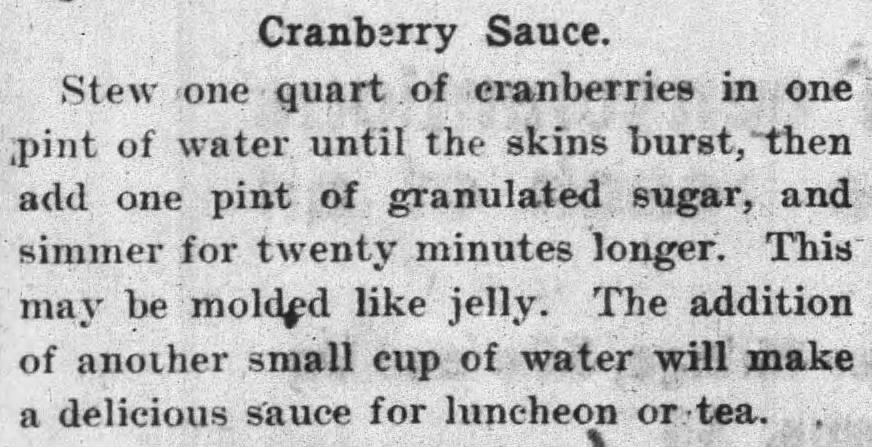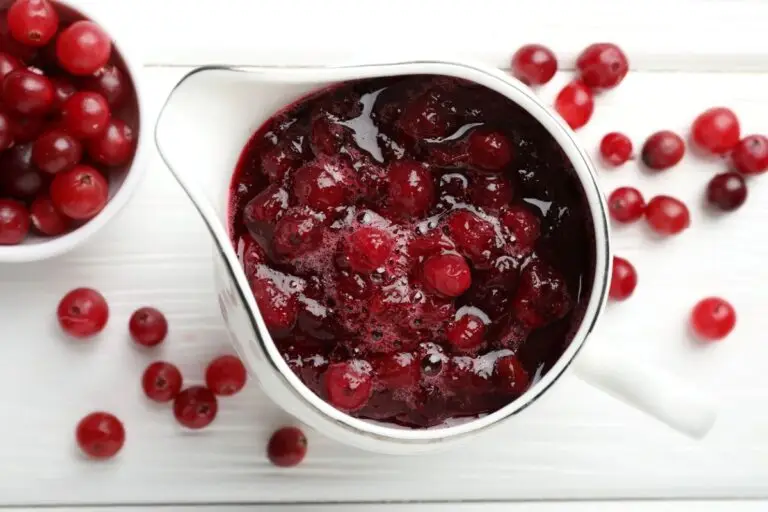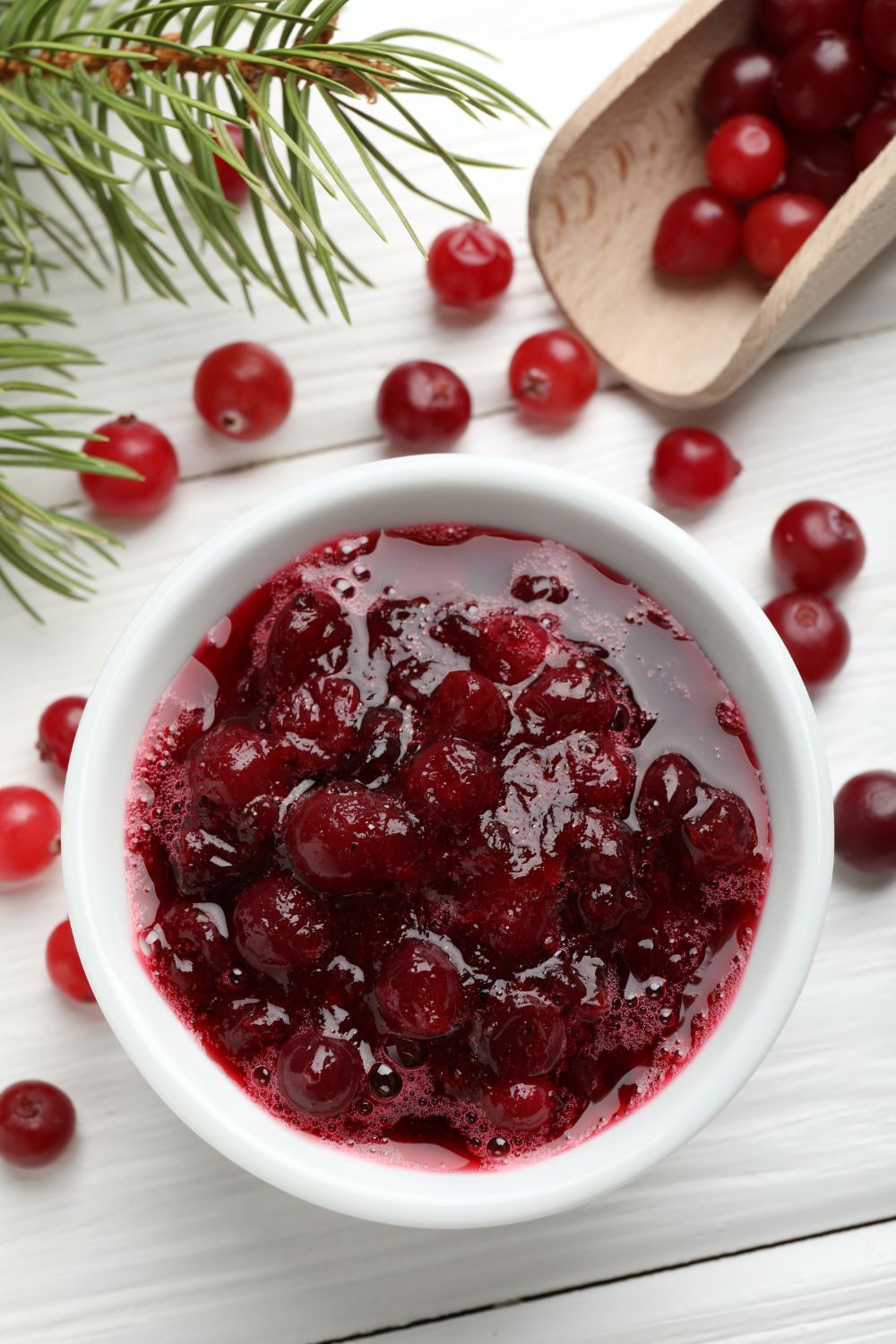This old fashioned homemade cranberry sauce delivers sweet-tart perfection in less than an hour with only three pantry staples. I've tested this 1903 recipe multiple times, and the unique ratio of cranberries to sugar creates a beautifully moldable sauce that holds its shape like the jellied versions of yesteryear but tastes infinitely better. The original instructions promise a delicious sauce for luncheon or tea, and they weren't exaggerating.
There's something quietly elegant about watching ruby-red cranberries burst and transform into glossy sauce, filling your kitchen with that sharp, fruity aroma that signals the holidays. The bubbling sound as the berries cook down feels timeless, connecting us to cooks who stood at their stoves over a century ago.
The 1903 Kitchen
When this cranberry sauce recipe first appeared in print, Theodore Roosevelt was President, and the Wright Brothers had just achieved their first flight. Home cooks were working with coal or wood-burning stoves that required constant temperature monitoring, making this simple recipe a blessing.

Fresh cranberries arrived by train from the bogs of Massachusetts and Wisconsin, often sold in small wooden boxes at the general store. Granulated sugar, while more affordable than in previous decades, was still precious enough to measure carefully. The concept of "molded like jelly" would have been instantly understood by any cook of that era, as gelatin desserts and molded salads were the height of refined entertaining.
This recipe mattered because it transformed tart, seasonal cranberries into an elegant accompaniment that elevated Sunday dinners and holiday feasts. The ability to mold it meant you could unmold a glistening crimson dome onto your finest china platter, impressing guests with minimal effort.
What Makes This Vintage Cranberry Sauce Special

Old Fashioned 1903 3-Ingredient Cranberry Sauce Recipe
This vintage 1903 cranberry sauce recipe uses just cranberries, water, and sugar to create a beautifully moldable, sweet-tart sauce. Simple, elegant, and far superior to anything from a can.
- Total Time: 40 minutes
- Yield: 2 cups or 8 servings 1x
Ingredients
- 4 cups (1 quart) fresh cranberries, rinsed and picked over
- 2 cups water, divided (1 pint for initial cooking, plus optional additional for desired consistency)
- 2 cups granulated sugar
Instructions
- Cook the cranberries: Place cranberries in a medium saucepan with 2 cups of water. Bring to a simmer over medium heat, stirring occasionally.
- Simmer until skins burst: Continue simmering for 10-15 minutes, stirring frequently, until most or all of the cranberry skins have burst open. You’ll hear popping sounds and see the berries collapse.
- Add sugar and simmer longer: Stir in the granulated sugar until completely dissolved. Continue simmering for 20 minutes longer, stirring frequently to prevent sticking. The mixture will thicken and become glossy.
- Adjust consistency if desired: The 1903 recipe notes that “the addition of another small cup of water will make a delicious sauce for luncheon or tea” if you prefer a thinner, pourable consistency rather than moldable.
- Cool and set: Transfer the cranberry sauce to a serving bowl or mold. Allow to cool at room temperature for 30 minutes, then refrigerate for at least 2 hours until completely set and chilled.
- Serve: If molded, dip the mold briefly in warm water and invert onto a serving platter. Otherwise, serve directly from the bowl.
- Prep Time: 5 mintues
- Cook Time: 35 minutes
- Category: Thanksgiving
- Method: Stovetop
- Cuisine: American
Nutrition
- Serving Size: ½ cup
- Calories: 220
- Sugar: 52g
- Sodium: 2mg
- Carbohydrates: 57g
- Fiber: 2g
How to Make Perfect Vintage Cranberry Sauce
Recipe Variations, Serving Ideas, and Storage
Recipe Variations
Frequently Asked Questions
Yes, frozen cranberries work well in this vintage recipe. Use them straight from the freezer without thawing, and add 2-3 extra minutes to the initial cooking time to account for the frozen berries.
1903 palates preferred sweeter condiments than we typically enjoy today. You can reduce the sugar to 1½ cups for a more modern, tart flavor while still maintaining the moldable texture.
The cranberries are ready for the sugar when most or all of the skins have burst open and the mixture looks thick and pulpy. You'll hear popping sounds as the berries collapse.
You certainly can, though it wouldn't be authentic to the 1903 original. If you want to add orange flavor, use ¼ cup orange juice in place of ¼ cup of the water, and stir in 1 teaspoon of orange zest at the end of cooking.
This refers to the firm, sliceable consistency that allows you to pour the warm sauce into a decorative mold, chill it, and then unmold it onto a serving platter where it holds its shape perfectly.
Bitterness usually comes from overcooking or burning the sugar. Make sure to stir frequently during the 20-minute sugar simmer and use medium-low heat rather than high heat.
Absolutely. Simply pour it into a serving bowl and chill. It will still have the same delicious flavor, just without the decorative molded shape.
Make it up to 2 weeks ahead and store it in the refrigerator, or up to 3 months ahead and freeze it. This is one of the most make-ahead-friendly holiday dishes.
Any decorative mold works, from vintage copper molds to modern silicone molds. A 2-cup capacity is perfect for this recipe. Lightly oil the mold before adding the warm sauce for easier unmolding.
What holiday memories does homemade cranberry sauce bring back for you? Did your grandmother serve it molded and sliced, or spooned from a bowl? If you make this old fashioned homemade cranberry sauce, please leave a rating and review below! I'd love to hear how this 1903 recipe compares to your family's traditions.

0 comments